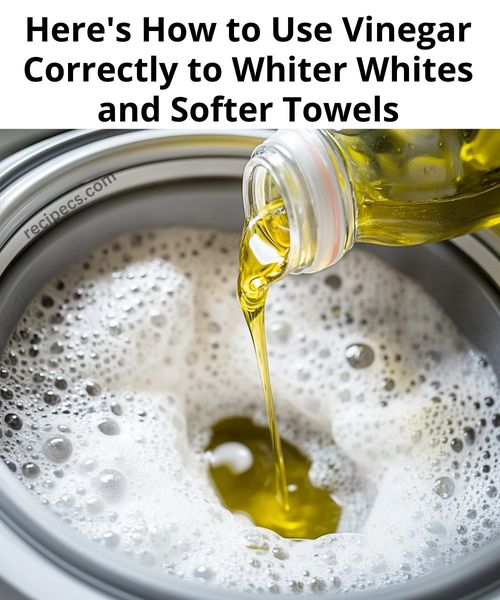ADVERTISEMENT
Pro Tip: If you want even softer towels, try soaking them in a vinegar solution (1 cup of vinegar in a bucket of water) for 30 minutes before washing. This deep-cleansing soak can revitalize old, rough towels.
3. For Stain Removal: Pre-Treat with a Vinegar Solution
For stubborn stains, create a mixture of 1 part vinegar and 1 part water and apply it directly to the stain. Let it sit for 10-15 minutes before washing as usual. The acetic acid in vinegar helps break down the stain particles, making them easier to lift during washing.
Pro Tip: This method works particularly well for coffee, tea, sweat, and deodorant stains. For tougher stains, you can add a small amount of baking soda to the mixture for an extra boost.
4. For Removing Mildew: Soak Towels in a Vinegar Solution
If your towels smell musty or have developed mildew, soak them in a solution of 1 cup of vinegar and 1 cup of water for an hour before washing. Vinegar’s antifungal properties help kill mold and mildew, eliminating that unpleasant odor.
Pro Tip: After soaking, wash the towels with a regular detergent and add another ½ cup of vinegar during the rinse cycle for maximum freshness.
Avoid Common Mistakes When Using Vinegar in Laundry
While vinegar is a fantastic natural laundry booster, it’s important to use it correctly to get the best results. Here are some common mistakes to avoid:
1. Using Too Much Vinegar
More is not always better. Using too much vinegar can weaken fabrics over time, especially natural fibers like cotton and wool. Stick to the recommended amounts (1 cup or less) to avoid any damage.
2. Mixing Vinegar with Bleach or Other Cleaners
Never mix vinegar with bleach or ammonia-based cleaners. Doing so can produce toxic chlorine gas, which is harmful to breathe in. Always use vinegar as a standalone additive or pre-treating solution.
3. Using Vinegar on Delicate Fabrics Without Testing
While vinegar is safe for most fabrics, some delicate materials like silk or rayon can be sensitive to acetic acid. Test a small, inconspicuous area of the fabric first to ensure there is no discoloration or damage before using vinegar on the entire garment.
4. Adding Vinegar Too Early in the Wash Cycle
Adding vinegar during the wash cycle when detergent is still active can neutralize some of the detergent’s cleaning power. Always add vinegar during the rinse cycle to maximize its benefits.
How Often Should You Use Vinegar in Your Laundry?
Incorporating vinegar into your laundry routine once a week is enough to maintain softer, fresher-smelling fabrics. If you’re dealing with particularly hard water or stiff towels, you can use it every time you wash those items.
Final Thoughts: Why Vinegar Is a Game-Changer for Laundry
Using vinegar in your laundry is a simple, effective way to achieve cleaner, brighter, and softer fabrics. It’s a cost-effective and environmentally friendly alternative to traditional bleach and fabric softeners. By following the right techniques and avoiding common mistakes, you’ll unlock the full potential of this household staple and transform your laundry routine.
Give these methods a try and see the difference for yourself. You’ll be amazed at how such a small change can lead to whiter whites, softer towels, and an overall fresher laundry experience!
